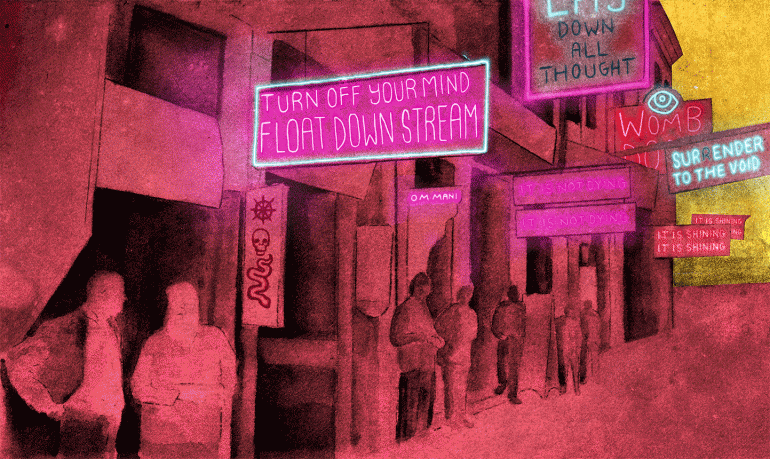Visual Communications
Murray Aston Joseph Barnes Jodie Byrne Finan Callaghan Tom Campion Áine Coll Kate Doherty Lily Gartner Chris Hanna Aoibheann Hand Bartek Janczak Kayley Kemple Shauna Langtry Megan McDonnell Marianna Mooney Póilín Nic Géidigh Caitlín Ní Rabhartaigh Lana O'Kiersey Karolina Olkowicz Gary Price David Rogers Laura-Ann Ryan Stephen Sheehan Sun YuyuChris Hanna
Nowhereville
In comics studies, sequential art is a term proposed by comics artist Will Eisner to describe art forms that use images deployed in a specific order for the purpose of graphic storytelling or conveying information. With its unconventional narrative structure, Nowhereville is a response to the term ‘sequential art’ and is an attempt to break free from the associations and preconceptions associated with the traditional panel structure of comics. The first departure Nowhereville makes from the traditional is that it exists in the digital world as opposed to print, as such, it takes full advantage of the unique possibilities this medium allows by making use of animation, voice acting and sound design to enrich the primary method of illustration.
One of the main challenges when making Nowhereville was to break away from the tradition of placing speech bubbles or passages of text beside the images. I think that words have the habit of taking something suggestive and reducing it to something definitive, in this way they can be seen as enforcing limitations when used as a tool of translation. To translate an image, a feeling, or thought into a language that doesn’t quite allow for the same nuance or abstraction is something I wanted to avoid, instead relying on images that need to be decoded and figured out. This idea has particular relevance to the world of sequential art and comics. When I read a comic that combines the written word with visual storytelling I can’t help but think that something is lost from both. The written word forces a particular interpretation of the image it is partnered with, this means the ambiguity of the image, and the possibility of multiple interpretations is lost. When you look at any piece of art and it touches you on an emotional level it is usually because it engages that part of you that doesn’t need to categorise and divide one thing from another with language in order to understand it. It simply is and that is enough, it doesn’t require explanation. This is why Nowhereville reads less as a story with an easily discernible plot and relies more on the ambiguous than the explicit, why language is used as part of a broader atmospheric device along with music to keep the sequence of images unspoilt by writing.
In comics studies, sequential art is a term proposed by comics artist Will Eisner to describe art forms that use images deployed in a specific order for the purpose of graphic storytelling or conveying information. With its unconventional narrative structure, Nowhereville is a response to the term ‘sequential art’ and is an attempt to break free from the associations and preconceptions associated with the traditional panel structure of comics. The first departure Nowhereville makes from the traditional is that it exists in the digital world as opposed to print, as such, it takes full advantage of the unique possibilities this medium allows by making use of animation, voice acting and sound design to enrich the primary method of illustration.
One of the main challenges when making Nowhereville was to break away from the tradition of placing speech bubbles or passages of text beside the images. I think that words have the habit of taking something suggestive and reducing it to something definitive, in this way they can be seen as enforcing limitations when used as a tool of translation. To translate an image, a feeling, or thought into a language that doesn’t quite allow for the same nuance or abstraction is something I wanted to avoid, instead relying on images that need to be decoded and figured out. This idea has particular relevance to the world of sequential art and comics. When I read a comic that combines the written word with visual storytelling I can’t help but think that something is lost from both. The written word forces a particular interpretation of the image it is partnered with, this means the ambiguity of the image, and the possibility of multiple interpretations is lost. When you look at any piece of art and it touches you on an emotional level it is usually because it engages that part of you that doesn’t need to categorise and divide one thing from another with language in order to understand it. It simply is and that is enough, it doesn’t require explanation. This is why Nowhereville reads less as a story with an easily discernible plot and relies more on the ambiguous than the explicit, why language is used as part of a broader atmospheric device along with music to keep the sequence of images unspoilt by writing.




